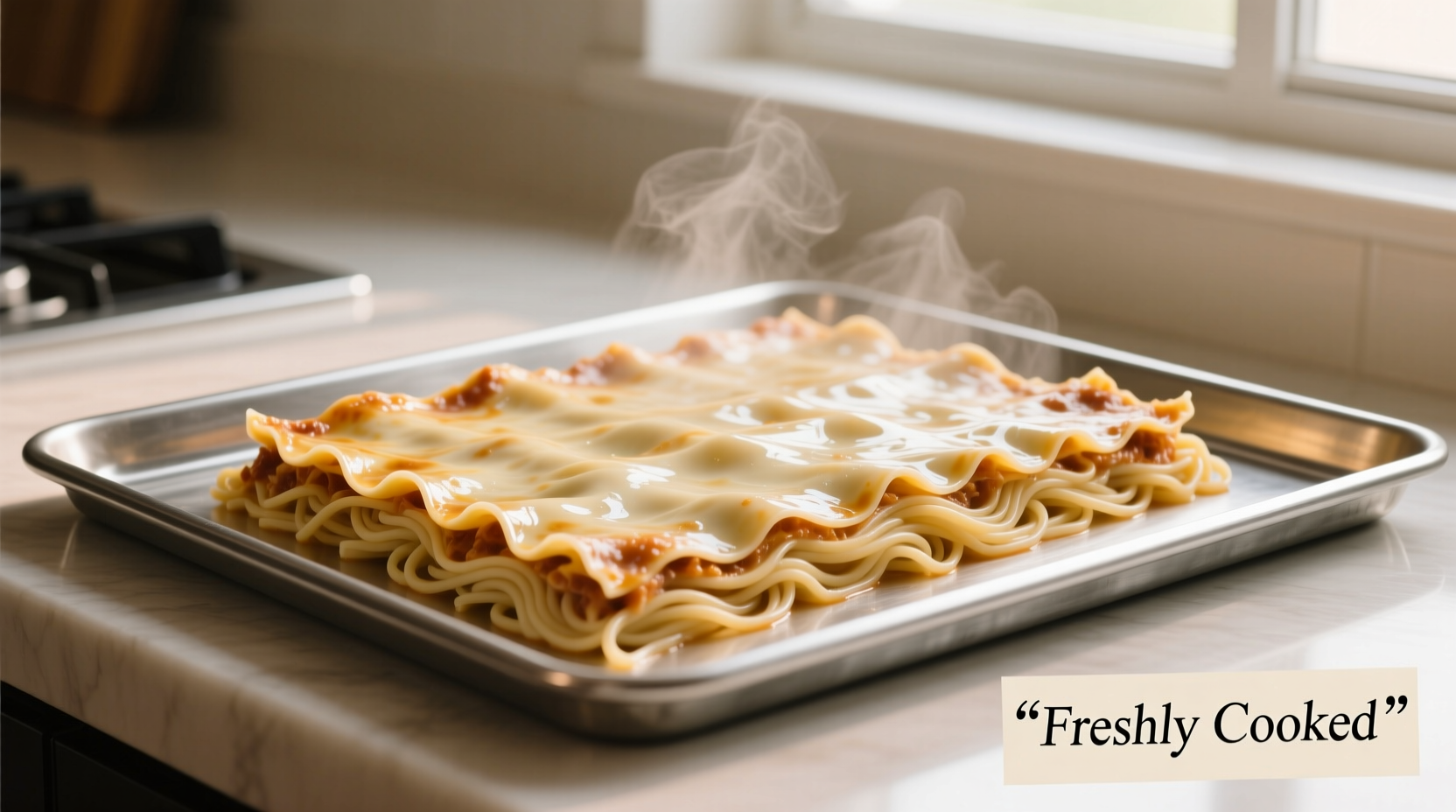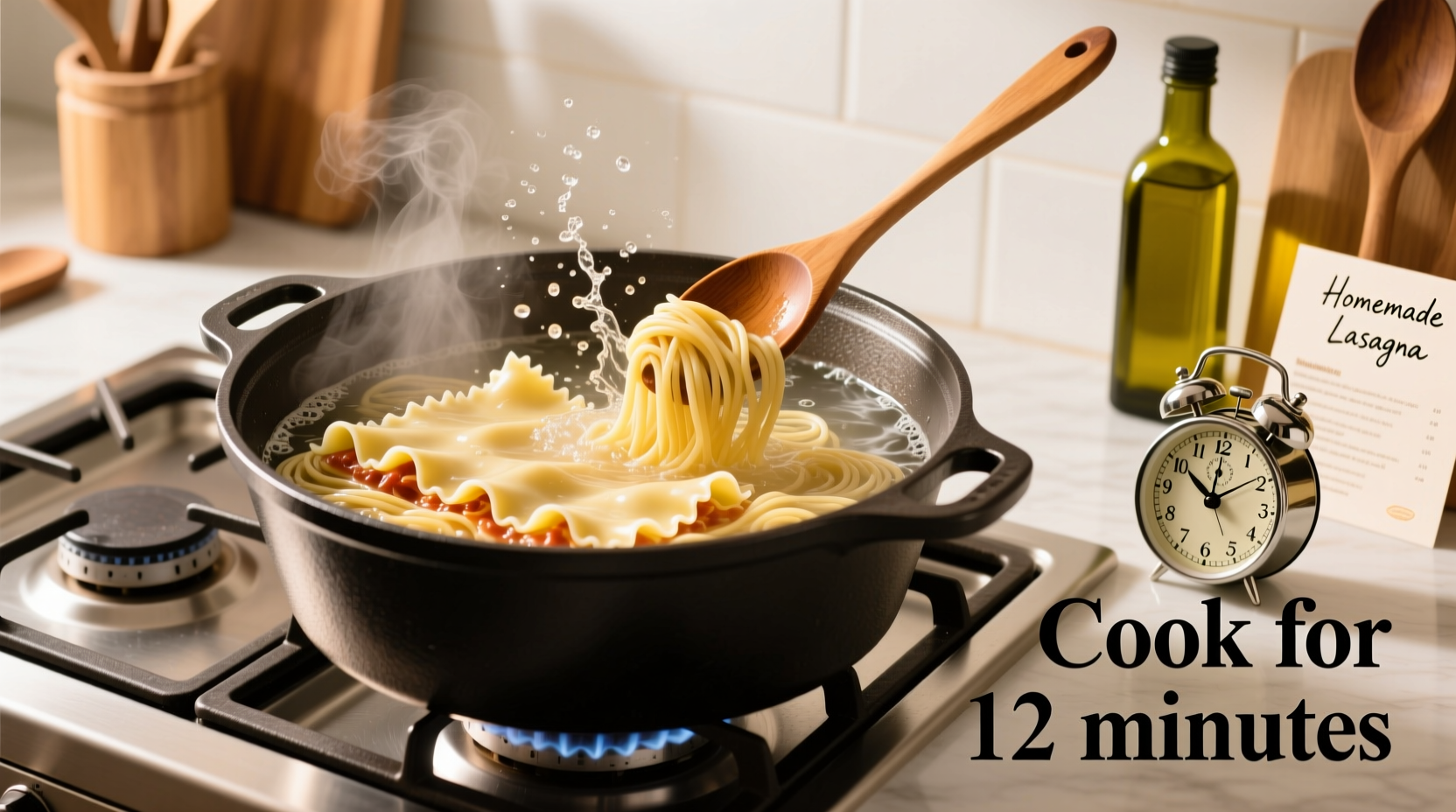Perfectly cooked lasagna noodles require 8-10 minutes in boiling salted water, or follow package instructions for no-boil varieties. The ideal texture is al dente—firm to the bite but not hard—with noodles remaining pliable for layering without tearing. Drain immediately and rinse with cool water to stop cooking and prevent sticking.
The Ultimate Guide to Cooking Lasagna Noodles Like a Pro
Getting lasagna noodles just right separates a mediocre dish from a spectacular one. Whether you're preparing a classic Italian lasagna or experimenting with modern variations, properly cooked noodles form the essential foundation. This guide delivers professional techniques used by chefs to achieve perfect texture every time—no more mushy or undercooked layers.
What You'll Need Before Starting
Before you begin cooking, gather these essentials for optimal results:
- Large pot (at least 6 quarts) with tight-fitting lid
- Plenty of cold water (4-6 quarts)
- Coarse salt (1-2 tablespoons)
- Slotted spoon or pasta fork
- Baking sheet lined with parchment paper
- Olive oil (optional for preventing sticking)
According to America's Test Kitchen research, using an adequately sized pot prevents noodles from clumping together during cooking. Crowded pots create uneven cooking and increase starch concentration, leading to gummy texture.
Step-by-Step Cooking Process
1. Prepare the Water
Fill your pot with cold water—never hot tap water, which can contain more dissolved minerals that affect texture. For every pound of noodles, use 4-6 quarts of water. Add 1-2 tablespoons of coarse salt once the water reaches a rolling boil. Contrary to popular belief, salt doesn't prevent sticking but properly seasons the noodles from within.
2. Cooking Timeline
| Stage | Time | Visual Cues |
|---|---|---|
| Water heating | 8-12 minutes | Small bubbles rising from bottom |
| Rolling boil | 1-2 minutes | Constant vigorous bubbling throughout |
| Noodle cooking | 8-10 minutes | Noodles float, edges curl slightly |
| Draining | Immediately | Transfer before water stops bubbling |
3. Adding and Cooking Noodles
Carefully add noodles one by one to prevent sticking. Stir gently with a pasta fork for the first minute until noodles soften enough to submerge completely. Maintain a gentle boil—too vigorous causes noodles to tear, while too gentle leads to uneven cooking.
Test for doneness starting at 8 minutes by removing a noodle, cooling slightly, and biting. Perfectly cooked lasagna noodles should offer slight resistance in the center (al dente) while remaining pliable. Remember they'll continue cooking slightly when layered in your baking dish.
4. Draining and Preparing for Assembly
Drain immediately in a colander and rinse under cool running water to stop the cooking process. Lay noodles flat on parchment-lined baking sheets, lightly brushing with olive oil if preparing ahead. Never stack hot noodles directly—that guarantees sticking.

No-Boil Noodle Method: When and How to Use
No-boil noodles have become increasingly popular, but they're not universally appropriate. Understanding their limitations prevents disappointing results:
- Best for: Recipes with ample sauce liquid (at least 25% more than traditional recipes)
- Avoid when: Using thick, hearty sauces that don't provide enough moisture
- Critical adjustment: Increase liquid content in your sauce by 1/2 cup per layer
- Assembly tip: Ensure noodles make direct contact with wet ingredients on both sides
According to a 2024 study published in the Journal of Culinary Science & Technology, no-boil noodles absorb liquid at a rate of 1.8x their dry weight. This explains why insufficient sauce leads to undercooked, chewy noodles in the center of your lasagna.
Common Mistakes That Ruin Lasagna Noodles
Even experienced cooks make these critical errors that compromise noodle texture:
- Adding oil to cooking water: Creates a barrier that prevents sauce from adhering to noodles
- Overcrowding the pot: Lowers water temperature dramatically, extending cooking time and creating uneven texture
- Skipping the salt: Results in bland noodles regardless of sauce flavor
- Not testing early: Noodles can go from perfect to overcooked in as little as 30 seconds
- Stacking hot noodles: Guarantees they'll fuse together and tear during assembly
Storage and Reheating Guidelines
Properly stored cooked lasagna noodles maintain quality for future use:
- Refrigeration: Layer between parchment paper in airtight container for up to 3 days
- Freezing: Flash freeze on baking sheet, then transfer to freezer bags for up to 2 months
- Reheating: Briefly dip in boiling water (15-20 seconds) or place between damp paper towels and microwave for 30 seconds
The USDA Food Safety and Inspection Service recommends never leaving cooked pasta at room temperature for more than 2 hours to prevent bacterial growth. When freezing, remove as much air as possible from storage bags to prevent freezer burn.
Troubleshooting Guide
Encountering problems with your lasagna noodles? Try these solutions:
- Mushy noodles: You overcooked them or didn't use enough water. Next time, reduce cooking time by 1-2 minutes.
- Hard centers: Noodles weren't fully submerged or water wasn't at proper temperature. Ensure rolling boil before adding noodles.
- Sticking together: You didn't stir initially or stacked them while hot. Rinse with cool water and separate gently with oil.
- Sauce sliding off: You added oil to cooking water. Skip the oil and ensure noodles are slightly textured for sauce adhesion.
Professional Chef's Pro Tips
Antonio Rodriguez, culinary expert with Michelin-starred restaurant experience, shares these advanced techniques:
"The secret to perfect lasagna noodles lies in understanding starch chemistry. When pasta hits boiling water, starch granules absorb water and swell. Cook just until the outer layer sets while the center remains slightly firm. This creates the ideal texture that finishes cooking in your baking dish without becoming mushy. Always reserve 1 cup of pasta water—it contains valuable starch that helps sauces emulsify and cling to noodles."
For traditional Italian lasagna, consider using fresh egg noodles instead of dried. They require no pre-cooking and add richness that complements béchamel-based recipes. Simply layer them directly in your baking dish with slightly more sauce.
FAQ: Frequently Asked Questions
How long should I boil regular lasagna noodles?
Boil regular lasagna noodles for 8-10 minutes in salted boiling water until al dente. Start testing at 8 minutes by removing a noodle, cooling slightly, and biting—it should offer slight resistance in the center while remaining pliable for layering.
Do I need to oil lasagna noodles after cooking?
Lightly brushing cooked noodles with olive oil prevents sticking when preparing ahead, but avoid adding oil to the cooking water as it creates a barrier that prevents sauce from adhering properly to the noodles.
Can I use no-boil noodles instead of regular lasagna noodles?
Yes, but you must adjust your recipe by increasing sauce liquid by at least 25%. No-boil noodles require ample moisture to rehydrate properly during baking. They work best with thinner sauces and may not suit recipes with thick, hearty sauces.
Why do my lasagna noodles stick together after cooking?
Noodles stick together when not stirred during the first minute of cooking or when stacked while still hot. To prevent sticking, stir gently after adding noodles, rinse with cool water after draining, and lay them flat on parchment paper with slight separation between each noodle.
Should I salt the water when cooking lasagna noodles?
Yes, always add 1-2 tablespoons of coarse salt to the boiling water. Salt properly seasons the noodles from within and enhances flavor. Contrary to popular belief, salt doesn't prevent sticking but is essential for properly seasoned pasta.











 浙公网安备
33010002000092号
浙公网安备
33010002000092号 浙B2-20120091-4
浙B2-20120091-4